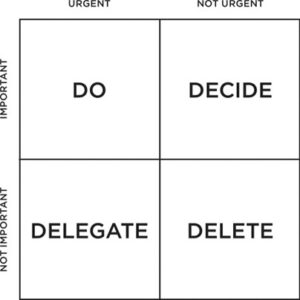Starting a new trimester can be overwhelming. Deciding which tasks to tackle first can feel paralyzing, and sometimes this translates to nothing getting done at all. I found myself in these moments quite often, until Steven Covey’s “The 7 Habits of Highly Effective People” offered a model that revolutionized my productivity. It’s the third habit in this book, “Put First Things First,” that offers a model to help prioritize tasks effectively. This four-quadrant method, adapted from the Eisenhower Matrix, categorizes tasks into a box with 4 quadrants, labeling each as “Urgent/Non-urgent” and “Important/Non-Important.”

Rosenfeld Media. Eisenhower Matrix. October 20, 2021. Available at: https://www.flickr.com/photos/rosenfeldmedia/51698837149. Accessed May 16, 2024. Licensed under CC BY 2.0. https://creativecommons.org/licenses/by/2.0/
- Quadrant One: Urgent and Important
These tasks demand immediate action—looming deadlines or crises. Addressing Quadrant One tasks is essential to prevent chaos.
- Quadrant Two: Important but Not Urgent
This quadrant is where the magic happens. Tasks here are essential but don’t require immediate attention. Focusing on Quadrant Two tasks today prevents them from becoming tomorrow’s Quadrant One emergencies.
- Quadrant Three: Urgent, but Not Important
These tasks seem urgent but are not essential to your goals, like answering non-critical texts or emails. They can distract from productive work.
- Quadrant Four: Neither Important, Nor Urgent
This is the least productive quadrant. These time-wasters, such as doom-scrolling or binge-watching, offer fleeting pleasure but detract from long-term goals.
Understanding these quadrants clarifies where to focus efforts for maximum productivity. Prioritizing important over urgent tasks and recognizing the difference between being busy and being productive is key. Spending more time in Quadrant Two (important but not urgent) reduces the stress of Quadrant One (urgent and important). Quadrant Three highlights the illusion of busyness without true productivity, while Quadrant Four shows the unfulfilling nature of trivial activities.
Stumbling upon this article might mean you’re lingering in Quadrant Four. So, let’s all make life easier on ourselves, shift to Quadrant Two tasks now to prevent them from becoming stressful Quadrant One crises later. Now that I’ve finished my Quadrant One task of writing this post, I’m moving on to my Quadrant Two summer goal: studying for boards.
References:
- Covey SR. The 7 Habits of Highly Effective People. New York, NY: Free Press; 1989.
- Rosenfeld Media. Eisenhower Matrix. October 20, 2021. Available at: https://www.flickr.com/photos/rosenfeldmedia/51698837149. Accessed May 16, 2024. Licensed under CC BY 2.0. https://creativecommons.org/licenses/by/2.0/



